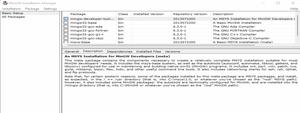Installing MinGW Tools for C/C++ and Changing Environment Variable
Last Updated :
06 Feb, 2023
MinGW is a native C/C++ compiler(GCC) which have free distributable import libraries and header files for building native Windows applications. In this tutorial, we are going to install MinGW for C/C++. These are a few steps that we have to perform to successfully install MinGW on our device.
How to Install the MinGW Tools for C/C++?
Step 1: Go to the MinGW website and click on Download. It will start downloading in 5 seconds.

Step 2: Double click and open the exe MinGW file and click install. It will automatically start downloading all the setups for the MinGW.
Step 3: After all of the setup click Continue. Now the MinGW installation manager will pop up.

Step 4: In the installation manager right click on every option and then click Mark for Installation.

Step 5: In the Installation, option-click Apply changes. And then select Apply. It will start downloading all the files. It will take 5-6 minutes. After finishing click on Close.

How to Change Environment Variables for MinGW
After successful installation of MinGW, next step is to change the environment location for MinGW.
Step 1: Go to the C drive on your device and search for the MinGW folder. And in the MinGW folder go to the bin folder and copy its path.

Step 2: Go to the control panel then go to System then Advanced system settings and then Environment variables.

Step 3: In the system variables search for path and then select Edit. Now add a new path to it by clicking New. Now paste the path and click ok.

This marks the complete installation of MinGW in the system.
Another method to change Environment Variable for MinGw.
Step 1: Go to the C drive on your device and search for the MinGW folder. And in the MinGW folder go to the bin folder and copy its path.

Step 2: Now go to this pc and right click there and click on show more properties and click on properties pointed by the arrow.

Step 3: Now click on Advanced system setting.

Step 4: Now click on environmental variables.

Step 5: Now in system variables click on path and click on edit button.

Step 6: Now click on new button and paste the copied path there as shown in photo.

Now click on "ok" button of step 6, 5 and 4. and then close all the windows and restart your pc.
This marks the complete installation of MinGW in the system.
Similar Reads
C++ Programming Language C++ is a computer programming language developed by Bjarne Stroustrup as an extension of the C language. It is known for is fast speed, low level memory management and is often taught as first programming language. It provides:Hands-on application of different programming concepts.Similar syntax to
5 min read
Non-linear Components In electrical circuits, Non-linear Components are electronic devices that need an external power source to operate actively. Non-Linear Components are those that are changed with respect to the voltage and current. Elements that do not follow ohm's law are called Non-linear Components. Non-linear Co
11 min read
Spring Boot Tutorial Spring Boot is a Java framework that makes it easier to create and run Java applications. It simplifies the configuration and setup process, allowing developers to focus more on writing code for their applications. This Spring Boot Tutorial is a comprehensive guide that covers both basic and advance
10 min read
Object Oriented Programming in C++ Object Oriented Programming - As the name suggests uses objects in programming. Object-oriented programming aims to implement real-world entities like inheritance, hiding, polymorphism, etc. in programming. The main aim of OOP is to bind together the data and the functions that operate on them so th
5 min read
Class Diagram | Unified Modeling Language (UML) A UML class diagram is a visual tool that represents the structure of a system by showing its classes, attributes, methods, and the relationships between them. It helps everyone involved in a project—like developers and designers—understand how the system is organized and how its components interact
12 min read
3-Phase Inverter An inverter is a fundamental electrical device designed primarily for the conversion of direct current into alternating current . This versatile device , also known as a variable frequency drive , plays a vital role in a wide range of applications , including variable frequency drives and high power
13 min read
Backpropagation in Neural Network Back Propagation is also known as "Backward Propagation of Errors" is a method used to train neural network . Its goal is to reduce the difference between the model’s predicted output and the actual output by adjusting the weights and biases in the network.It works iteratively to adjust weights and
9 min read
30 OOPs Interview Questions and Answers [2025 Updated] Object-oriented programming, or OOPs, is a programming paradigm that implements the concept of objects in the program. It aims to provide an easier solution to real-world problems by implementing real-world entities such as inheritance, abstraction, polymorphism, etc. in programming. OOPs concept is
15 min read
What is Vacuum Circuit Breaker? A vacuum circuit breaker is a type of breaker that utilizes a vacuum as the medium to extinguish electrical arcs. Within this circuit breaker, there is a vacuum interrupter that houses the stationary and mobile contacts in a permanently sealed enclosure. When the contacts are separated in a high vac
13 min read
Polymorphism in Java Polymorphism in Java is one of the core concepts in object-oriented programming (OOP) that allows objects to behave differently based on their specific class type. The word polymorphism means having many forms, and it comes from the Greek words poly (many) and morph (forms), this means one entity ca
7 min read